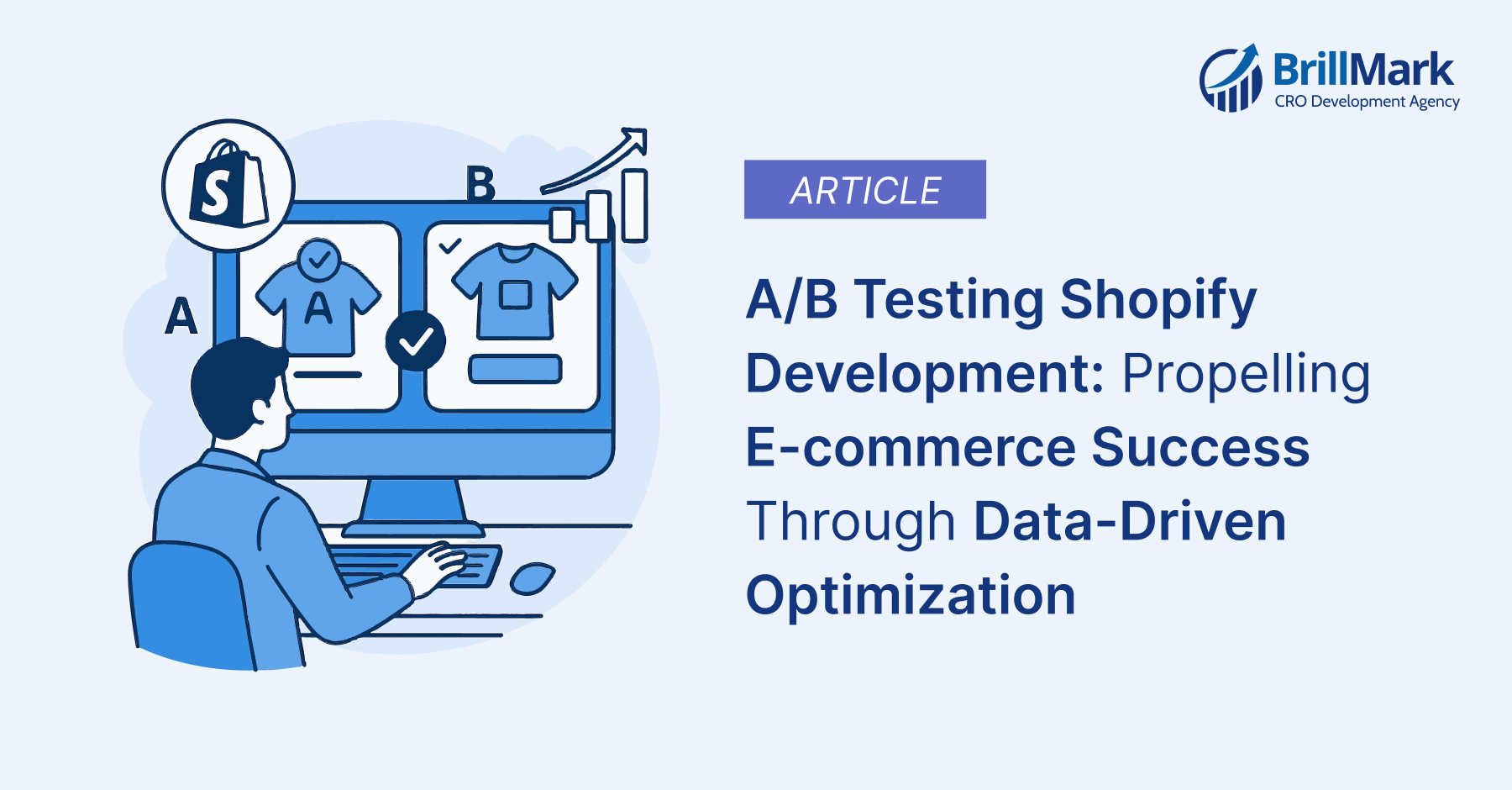In the relentless current of e-commerce, merely existing is falling behind. At Brillmark, we understand that Shopify store owners and developers are constantly striving for that competitive edge. It’s about converting more. Curious visitors should become loyal customers. Elevate their shopping experience to undoubtedly amplify revenue. While intuition and industry wisdom offer a solid foundation, true optimization demands a scientific approach. This is precisely where A/B testing, integrated seamlessly into your Shopify development process. Which can go from a beneficial practice to a vital solution.
This article from Brillmark experts explores A/B testing within Shopify. A well-streamlined process gives you insights. Use these to transform your store’s performance through informed decisions.
How to Do A/B Testing in Shopify Platforms?: In Brief
At its core, A/B testing – often referred to as split testing. It is a method of comparing two versions of a webpage or app element to pinpoint which one performs better.
For Shopify, this means presenting two variations (A and B) of a specific page element, design, or user flow to different segments of your audience simultaneously.
Measure key e-commerce metrics like conversion rates, bounce rates, average order value, and more. This way, you can objectively identify which version yields superior results.
For Shopify developers, A/B testing is not just marketing; it’s critical for e-commerce optimization and development. It demands careful experiment design, often requiring strategic Shopify theme customization, precise frontend development, and sometimes intricate backend integration. This ensures accurate deployment and reliable data collection.
Why A/B Testing is Indispensable for Shopify Success
In today’s fiercely competitive market, relying on gut feelings for design and functionality choices is a gamble. A/B testing provides the empirical evidence. You need to be confident while implementing changes that directly impact your bottom line.
Boosting Conversion Rates Through Strategic A/B Tests
The most immediate and impactful benefit of A/B testing is its direct contribution to conversion rate optimization (CRO). Even small design choices matter. The color of a “Buy Now” button, or where a trust badge sits, can greatly affect buying. Testing variations helps you learn. You find what resonates with your audience. You also discover what might stop them from buying.
Small changes can have big impacts. A tiny tweak to your product page might boost “Add to Cart” clicks by 5%. You’ll know this. You can then focus on it more. Over many visitors, this “small” gain means much more revenue. A/B tests find these key chances. They turn more visitors into buyers. This directly boosts your sales.
1. Enhance User Experience (UX) by Utilising the Data You Already Have
A seamless and intuitive user experience (UX) is paramount for retaining customers and fostering repeat purchases. A/B testing allows you to refine your store’s customer journey. Test different navigation structures, form layouts, content readability, and interactive elements.
Customers might abandon their carts at certain steps, or a call-to-action might be unclear. To fix this, create variants that address these potential UX bottlenecks. Then, test them against your existing design. This process provides actionable insights into how users truly interact with your store. It’s an iterative process guided by real user behavior data. This ensures your Shopify theme customization and design choices are always user-centric. Ultimately, it boosts engagement and satisfaction.
2. Making Informed Decisions: By Analysing the A/B Test Results
The era of making design or feature decisions based solely on personal preference or anecdotal evidence is, thankfully, behind us. A/B testing empowers you to justify every significant change with tangible data. This also helps present stakeholders with concrete evidence. This evidence mostly relates to how a particular A/B Test variant’s performance has positively impacted a key e-commerce metric. In your reports, include KPIs such as increased sign-ups, reduced bounce rates, or a higher average order value.
This shift to a data-driven culture fosters a more strategic approach to development and marketing. It minimizes risk, maximizes your resources’ impact. Every change implemented on your Shopify store becomes a calculated step forward, not a leap in the dark.
Multivariate Testing vs. A/B Testing: When to Use?
While A/B testing compares two distinct versions, it’s not the only tool in the optimization toolkit:
- A/B Testing (Split Testing): compares two versions (A vs. B) of a single element or page, like a red versus green button. It’s simple, effective for isolated changes, and provides clear insights.
- Multivariate Testing (MVT): tests multiple elements on a single page simultaneously, for example, different headlines, images, and call-to-action button texts at once.
When to Use MVT: MVT is powerful when elements might influence each other, aiming for the optimal combination.
Considerations: However, MVT requires significantly more traffic and longer test durations for statistical significance, making it inherently more complex to set up and analyze
For most Shopify development, A/B testing is generally recommended first due to its simplicity and clearer, more direct insights. MVT is best for highly trafficked pages that optimize multiple interconnected variables. Where traffic volume supports it.
Avoid Premature Conclusions and Define Test Duration Beforehand
Patience isn’t just a virtue in life; it’s essential for successful A/B testing.
- Run Tests Long Enough: A general rule is 7-14 days. This accounts for weekly patterns and ensures stable results.
- Achieve Statistical Significance: Declare a winner only after reaching statistical significance (e.g., 90% or 95% confidence). This ensures reliable findings.
- Consider Sample Size: Ensure enough visitors see each variant. This produces statistically reliable results. Most testing tools have calculators for the right sample size.
Common Pitfalls to Avoid in Shopify A/B Testing
Even with the best intentions, A/B testing can go awry. Here are some common pitfalls Brillmark helps clients avoid:
- Even with the best intentions, A/B testing can go wrong. Here are some common mistakes Brillmark helps clients avoid:
- Testing Too Many Elements: This makes it impossible to know which change caused what. Stick to one main variable per A/B test.
- Ignoring Statistical Significance: This is a major error in testing. It can lead to wrong positive or negative results. This means potentially harmful decisions.
- Running Tests Too Short: This results in unreliable data. It leads to incorrect conclusions.
- No Clear Hypothesis: This means aimless testing. There are no clear learning goals.
- Not Documenting Results: Forgetting past lessons and repeating errors leads to stagnation.
- Neglecting Mobile Experience: Most Shopify traffic is mobile. Ensure your tests include this vital audience.
- Introducing Bias: Letting personal ideas or prior beliefs sway the test setup or interpretation can distort results.
Documenting Your Tests: A Guide for Future Optimization
Maintaining a central repository for all your A/B test data is not just good practice; it’s an investment in your future optimization efforts. We recommend including:
- Hypothesis: What you aimed to prove or disprove.
- Variants: Screenshots or detailed descriptions of the changes made.
- Duration: The start and end dates of the test.
- Metrics: Key e-commerce metrics tracked and their performance for each variant.
- Results: Clearly state the winner/loser and the achieved statistical significance.
- Learnings: Crucially, document why you think the winner won, and any unexpected insights gained.
- Next Steps: What was implemented as a result, and what future tests are planned based on these learnings?
Future Trends in Shopify Optimization and AI-Powered Testing
The field of e-commerce optimization is far from static; it’s continuously evolving.
- AI and machine learning are increasingly used to personalize content. They dynamically recommend products and offers based on user behavior. This goes beyond simple A/B tests. It leads to continuous, adaptive optimization.
- Automated Experimentation: AI can automate much of the A/B testing process. It assists with forming hypotheses and designing experiments. It also finds ideal user groups. AI can even suggest winning options based on predictive analysis.
- Behavioral Economics Integration: A deeper look at psychological triggers will lead to better tests. These triggers include scarcity, urgency, and social proof.
- Headless Commerce & Micro-optimization: For Shopify Plus stores, moving to headless architectures is strategic. This allows for more detailed, high-performance A/B testing. It tests at the component level. This offers unmatched flexibility.
Cross-domain local storage for A/B testing presents complex challenges. But with the right techniques and tools, you can create robust solutions. These solutions maintain experiment integrity across multiple domains. According to recent CRO statistics, AI-driven personalized recommendations are proving to be a game-changer. Studies show they can increase conversion rates by 15-20%. This makes cross-domain testing even more vital for businesses in 2025. Brillmark specializes in navigating these complexities. We ensure your experiments are accurate and effective, no matter your store’s architecture.
Conclusion: Empowering Your Shopify Store with Intelligent Development
A/B test experimentation in Shopify development isn’t just technical; it’s strategic for e-commerce growth. By embracing systematic split testing, you can define meticulous hypotheses. This leverages data to create the best user experience. You can continually refine your store, enhancing the overall customer journey for user experience (UX) design. This is the right time to unlock significant improvements in your conversion rate optimization (CRO).
Developers must master client-side vs. server-side testing and understand statistical significance. Efficiently customizing Shopify themes for experiments is also invaluable.
In this competitive digital landscape, stores that consistently test, learn, and adapt are the ones that will truly thrive. Equip your Shopify store with the power of intelligent development. Let Brillmark help you unlock its full potential and watch your e-commerce metrics soar.











